Holly Thompson's Blog, page 26
October 23, 2013
Author Visits--Offering Motivation and Widening Worlds
Not long ago I made an author visit in Kyoto to Doshisha International Junior/Senior High School, also referred to as Doshisha International. See my earlier post on this visit: Visiting International Students in Kyoto for a glimpse at this visit that had so many varied and energizing components.
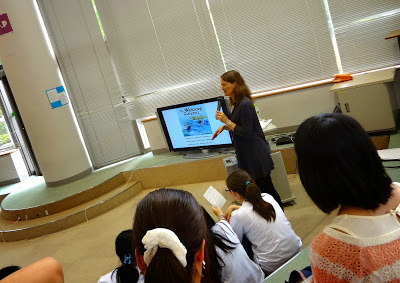 Photo courtesy of Doshisha International Junior/Senior High SchoolNow, teacher Sarah Ogawa has shared an in-depth write-up of that visit on ChildResearch.net titled "A 'Real' Writer Comes to School: An Author Visit Event at our Junior/Senior High School." If you want to know what author school visits are all about, this is a great intro! The article examines the purpose for this author visit and the effect on the students.
Photo courtesy of Doshisha International Junior/Senior High SchoolNow, teacher Sarah Ogawa has shared an in-depth write-up of that visit on ChildResearch.net titled "A 'Real' Writer Comes to School: An Author Visit Event at our Junior/Senior High School." If you want to know what author school visits are all about, this is a great intro! The article examines the purpose for this author visit and the effect on the students.
For me, this was a particularly gratifying author visit; the day was so well prepared for by the coordinators and the teachers. Class activities relating to my books had begun prior to my visit, there was great advance buzz, the presentations and class groups were varied, and exit surveys were even conducted of students and teachers. Because of the solid preparation, students were engaged and responsive--a gift to any presenter. There was even a student-directed video interview.
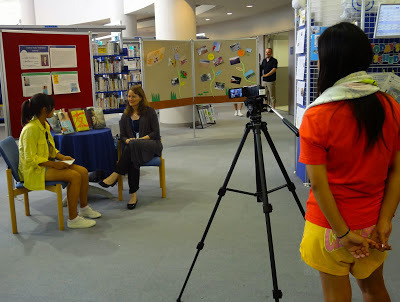 Photo courtesy of Doshisha International Junior/Senior High School
Photo courtesy of Doshisha International Junior/Senior High School
Watch the interview here:
As a long-time educator, I love doing author visits and interacting with students, trying to excite them about writing, and, as the article suggests, widening their worlds and motivating them to read fiction and to write their own stories. But in all my author visits, it has been rare to see such a detailed and insightful post-visit write-up. Thank you, Sarah Ogawa!
 Photo courtesy of Doshisha International Junior/Senior High SchoolNow, teacher Sarah Ogawa has shared an in-depth write-up of that visit on ChildResearch.net titled "A 'Real' Writer Comes to School: An Author Visit Event at our Junior/Senior High School." If you want to know what author school visits are all about, this is a great intro! The article examines the purpose for this author visit and the effect on the students.
Photo courtesy of Doshisha International Junior/Senior High SchoolNow, teacher Sarah Ogawa has shared an in-depth write-up of that visit on ChildResearch.net titled "A 'Real' Writer Comes to School: An Author Visit Event at our Junior/Senior High School." If you want to know what author school visits are all about, this is a great intro! The article examines the purpose for this author visit and the effect on the students.For me, this was a particularly gratifying author visit; the day was so well prepared for by the coordinators and the teachers. Class activities relating to my books had begun prior to my visit, there was great advance buzz, the presentations and class groups were varied, and exit surveys were even conducted of students and teachers. Because of the solid preparation, students were engaged and responsive--a gift to any presenter. There was even a student-directed video interview.
 Photo courtesy of Doshisha International Junior/Senior High School
Photo courtesy of Doshisha International Junior/Senior High SchoolWatch the interview here:
As a long-time educator, I love doing author visits and interacting with students, trying to excite them about writing, and, as the article suggests, widening their worlds and motivating them to read fiction and to write their own stories. But in all my author visits, it has been rare to see such a detailed and insightful post-visit write-up. Thank you, Sarah Ogawa!
Published on October 23, 2013 20:16
October 22, 2013
COETAIL: Google+ Hangouts for Authors
Another post toward obtaining my Certificate in Educational Technology and Information Literacy (COETAIL)
Last week because of the typhoon, our COETAIL face-to-face class was canceled and we met instead with Google+ Hangouts. While I'm a frequent user of Skype, as written about in this earlier COETAIL post, I hadn't joined a Google+ Hangout before.
At the COETAIL hangout, I was definitely not the only first-timer. Some of us were learning and adapting as the session progressed (I discovered the un-mute button in the last two minutes of our Hangout). A few participants were only able to instant-message chat, and not join in the audio/video conversation. Nonetheless, the discussion actually proceeded smoothly and fairly easily, and many of the COETAIL cohort were on video.
What is Google+ Hangouts? Briefly, Google+ Hangouts allows for video and audio conversations.
 Left to right: authors Holly Thompson, Mariko Nagai, Suzanne KamataUp to ten user screens can be visible at a time, and an unlimited number of participants can participate via audio. Read this Intro to Google Hangouts article in the Huffington Post if you are new to Hangouts. See also author/illustrator Debbie Ohi's Google + Guides and Tips for Newbies.
Left to right: authors Holly Thompson, Mariko Nagai, Suzanne KamataUp to ten user screens can be visible at a time, and an unlimited number of participants can participate via audio. Read this Intro to Google Hangouts article in the Huffington Post if you are new to Hangouts. See also author/illustrator Debbie Ohi's Google + Guides and Tips for Newbies.
Why haven't I used Hangouts before? I was thinking throughout the COETAIL Hangout. Maybe because I love Skype?
In any case, for writers, I can envision various applications for Google Hangouts:
School Visits Virtual author visits can be done with Skype or Google Hangouts. For Google savvy schools and teachers, Hangouts might be a great option. See Cynthia Leitich Smith's post How Authors Can Connect with Readers with Google+ Hangout.
Critique Groups For critique groups composed of writers, illustrators or translators based in far-flung locations, video conferencing with Hangouts could work well.
Discussions and Meet-ups For themed discussions (about a particular book, craft or technique, or just a casual weekly meet-up) Google Hangouts could enable group members spread over a wide area to participate in a virtual face-to-face discussion. See this post by Debbie Ohi about a Google+ Hangout illustrator meet-up.
Virtual Conference Attendance Via Skype or Google+ Hangouts, members of a group who can't physically attend a conferences might be able to attend virtually. If WiFi is available at a conference venue (not a given in Japan), virtual attendance by Google+ Hangout invitation might be possible.
Panel Presentations Offering a virtual "panel presentation" would be possible with Google+ Hangout. Several speakers could present on a particular topic, then take questions from participants. This could be shared publicly via YouTube (Hangouts On Air) or it could be open to a closed group.
As Regional Advisor of the Japan chapter of the Society of Children's Book Writers and Illustrators (SCBWI Japan), I'm always aware that we could be doing more to connect with our author, illustrator and translator members who are spread all over Japan. But whereas in COETAIL, participants are already frequent Google, Google Docs and Google Apps users, within SCBWI Japan, members have widely varying levels of tech know-how, and use different computer systems. Would it work? Would enough people be interested? Would Google+ Hangouts be easy for everyone to use?
I decided to test Google+ Hangout with a few members to discuss this issue. I set up a meeting with three far-flung Japan-based YA authors: Benjamin Martin in Okinawa, Suzanne Kamata in Shikoku and Mariko Nagai in Tokyo. We didn't manage to catch Ben, but Suzanne, Mariko and I were able to test Hangouts and discuss ways of using this feature with SCBWI members.
Results:
Audio was problematic some of the time. Now and then it sounded like we were under water, and there were some long audio and video delays. Note Mariko's facial expression as we tried getting around this.
 Left to right: Authors Holly Thompson, Mariko Nagai, Suzanne Kamata
Left to right: Authors Holly Thompson, Mariko Nagai, Suzanne Kamata
With 3 participants, audio and video was better than with two (perhaps due to one member accessing via smart phone?). For more than a few users on a Hangout, having a leader will make things easier. Users may need a system for taking turns to speak, and may need to be introduced to the mute button. Talking at the same time makes it difficult to understand anything; background noise can be very loud. Participants should create a Google account in advance and need a recognizable avatar or photo to make it easy for the host to safely send invitations to right people for the Hangout.
I'm not sure if Google+ is better than Skype for video conferencing. Skype requires the host to have a Premier account, but as with Google+ up to 10 users can participate at a time.
In any case, this is an area we will pursue and hope to have more video conference interaction available soon within SCBWI Japan.
Last week because of the typhoon, our COETAIL face-to-face class was canceled and we met instead with Google+ Hangouts. While I'm a frequent user of Skype, as written about in this earlier COETAIL post, I hadn't joined a Google+ Hangout before.
At the COETAIL hangout, I was definitely not the only first-timer. Some of us were learning and adapting as the session progressed (I discovered the un-mute button in the last two minutes of our Hangout). A few participants were only able to instant-message chat, and not join in the audio/video conversation. Nonetheless, the discussion actually proceeded smoothly and fairly easily, and many of the COETAIL cohort were on video.
What is Google+ Hangouts? Briefly, Google+ Hangouts allows for video and audio conversations.
 Left to right: authors Holly Thompson, Mariko Nagai, Suzanne KamataUp to ten user screens can be visible at a time, and an unlimited number of participants can participate via audio. Read this Intro to Google Hangouts article in the Huffington Post if you are new to Hangouts. See also author/illustrator Debbie Ohi's Google + Guides and Tips for Newbies.
Left to right: authors Holly Thompson, Mariko Nagai, Suzanne KamataUp to ten user screens can be visible at a time, and an unlimited number of participants can participate via audio. Read this Intro to Google Hangouts article in the Huffington Post if you are new to Hangouts. See also author/illustrator Debbie Ohi's Google + Guides and Tips for Newbies.Why haven't I used Hangouts before? I was thinking throughout the COETAIL Hangout. Maybe because I love Skype?
In any case, for writers, I can envision various applications for Google Hangouts:
School Visits Virtual author visits can be done with Skype or Google Hangouts. For Google savvy schools and teachers, Hangouts might be a great option. See Cynthia Leitich Smith's post How Authors Can Connect with Readers with Google+ Hangout.
Critique Groups For critique groups composed of writers, illustrators or translators based in far-flung locations, video conferencing with Hangouts could work well.
Discussions and Meet-ups For themed discussions (about a particular book, craft or technique, or just a casual weekly meet-up) Google Hangouts could enable group members spread over a wide area to participate in a virtual face-to-face discussion. See this post by Debbie Ohi about a Google+ Hangout illustrator meet-up.
Virtual Conference Attendance Via Skype or Google+ Hangouts, members of a group who can't physically attend a conferences might be able to attend virtually. If WiFi is available at a conference venue (not a given in Japan), virtual attendance by Google+ Hangout invitation might be possible.
Panel Presentations Offering a virtual "panel presentation" would be possible with Google+ Hangout. Several speakers could present on a particular topic, then take questions from participants. This could be shared publicly via YouTube (Hangouts On Air) or it could be open to a closed group.
As Regional Advisor of the Japan chapter of the Society of Children's Book Writers and Illustrators (SCBWI Japan), I'm always aware that we could be doing more to connect with our author, illustrator and translator members who are spread all over Japan. But whereas in COETAIL, participants are already frequent Google, Google Docs and Google Apps users, within SCBWI Japan, members have widely varying levels of tech know-how, and use different computer systems. Would it work? Would enough people be interested? Would Google+ Hangouts be easy for everyone to use?
I decided to test Google+ Hangout with a few members to discuss this issue. I set up a meeting with three far-flung Japan-based YA authors: Benjamin Martin in Okinawa, Suzanne Kamata in Shikoku and Mariko Nagai in Tokyo. We didn't manage to catch Ben, but Suzanne, Mariko and I were able to test Hangouts and discuss ways of using this feature with SCBWI members.
Results:
Audio was problematic some of the time. Now and then it sounded like we were under water, and there were some long audio and video delays. Note Mariko's facial expression as we tried getting around this.
 Left to right: Authors Holly Thompson, Mariko Nagai, Suzanne Kamata
Left to right: Authors Holly Thompson, Mariko Nagai, Suzanne KamataWith 3 participants, audio and video was better than with two (perhaps due to one member accessing via smart phone?). For more than a few users on a Hangout, having a leader will make things easier. Users may need a system for taking turns to speak, and may need to be introduced to the mute button. Talking at the same time makes it difficult to understand anything; background noise can be very loud. Participants should create a Google account in advance and need a recognizable avatar or photo to make it easy for the host to safely send invitations to right people for the Hangout.
I'm not sure if Google+ is better than Skype for video conferencing. Skype requires the host to have a Premier account, but as with Google+ up to 10 users can participate at a time.
In any case, this is an area we will pursue and hope to have more video conference interaction available soon within SCBWI Japan.
Published on October 22, 2013 02:40
October 20, 2013
COETAIL: Political Cartoons in the EFL Classroom
Another post toward obtaining my Certificate in Educational Technology and Information Literacy (COETAIL)
For a number of years I've taught an Advanced English course called Topic-Based Discussion at my university in Japan. In this fifteen week course, our class discussions revolve around questions relating to a text, data, images or video, or a combination, and I always devote two of the fifteen weeks to Political Cartoons. I use the site Cagle.com, created by cartoonist Daryl Cagle (who, incidentally, gave a great talk in Tokyo several years ago at the Hara Museum of Contemporary Art). While the Cagle site is heavily American, there are many cartoons to choose from, and the Trending Topics make them easily searchable for my students.
Some helpful online lesson plans about political cartoons include It's No Laughing Matter from the U.S. Library of Congress Classroom Materials; Analyzing the Purpose and Meaning of Political Cartoons from ReadWriteThink; and Interpreting Political Cartoons in the History Classroom from TeachingHistory.org. I've adapted and created a simple lesson plan that suits the rather loose aims of our discussion course--to develop students' abilities to prepare for, engage in and reflect upon energetic, in-depth discussions on a wide variety of topics in English.
I updated my Political Cartoon plans recently. First we will examine and analyze a cartoon together that I'll project on the screen (only one computer in this classroom). We'll open with this cartoon from the 2013 trending topic "Horse Meat" by U.S. cartoonist Pete Bagley about the recent horse meat scandal in Europe.
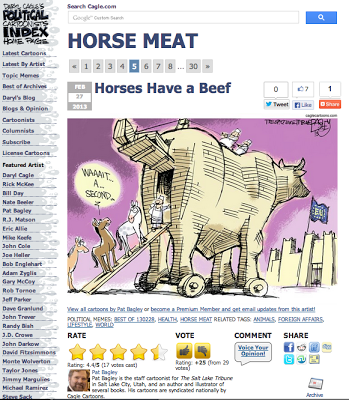 Cartoon by Pete Bagley on Cagle.comThe students will view the cartoon only--they will not see the words "Horse Meat"--so first they will try to discern the topic of the cartoon and the event to which it refers. They'll identify confusing points, if any, and research (on the single computer) if necessary. Then we'll discuss the message of the cartoon and identify any symbols, and look closely at the text and images used to convey the message. Students will be asked to try to explain the opinion(s) expressed by the cartoonist and whether or not they agree, and finally we will discuss whether or not the cartoon is persuasive or effective and why.
Cartoon by Pete Bagley on Cagle.comThe students will view the cartoon only--they will not see the words "Horse Meat"--so first they will try to discern the topic of the cartoon and the event to which it refers. They'll identify confusing points, if any, and research (on the single computer) if necessary. Then we'll discuss the message of the cartoon and identify any symbols, and look closely at the text and images used to convey the message. Students will be asked to try to explain the opinion(s) expressed by the cartoonist and whether or not they agree, and finally we will discuss whether or not the cartoon is persuasive or effective and why.
I'll then have the students examine additional cartoons from the Cagle site in pairs, and student pairs will present their cartoon and the analysis to the class. We'll also discuss this recent Dahl's Japan cartoon in the Japan Times about the TPP and tariff concessions.
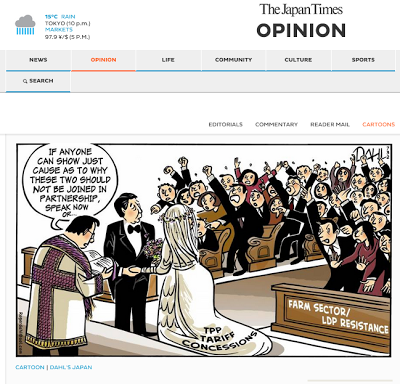 In preparation for the following week's class, students will visit Cagle.com to search for a cartoon to share and will prepare to lead discussion about that cartoon. In the second week we also will examine some broader questions about political cartoons: Are they meant to be funny? What role to political cartoons play in news media? How important are they for conveying news?
In preparation for the following week's class, students will visit Cagle.com to search for a cartoon to share and will prepare to lead discussion about that cartoon. In the second week we also will examine some broader questions about political cartoons: Are they meant to be funny? What role to political cartoons play in news media? How important are they for conveying news?
And since the class this year includes Japanese students who have lived abroad for significant periods of time, as well as students from China and Vietnam, I'll also have them search for a cartoon from either Japan, their home culture, or another culture they are familiar with, and we'll discuss those as well.
Since political cartoons are image based, this unit always grabs students' attention. Yet analyzing the cartoons is challenging and often depends on political and historical context and current event awareness. It's a perfect basis for discussion. The Political Cartoons unit always jumpstarts a higher level of discussion in the course, and I'm looking forward to doing this unit with this particular group of students. They seem to thrive on discussion--they question, provoke and challenge each other in a positive, energizing way, and at the end of the ninety-minute period they linger to talk more. I'm sure it will be lively.
For a number of years I've taught an Advanced English course called Topic-Based Discussion at my university in Japan. In this fifteen week course, our class discussions revolve around questions relating to a text, data, images or video, or a combination, and I always devote two of the fifteen weeks to Political Cartoons. I use the site Cagle.com, created by cartoonist Daryl Cagle (who, incidentally, gave a great talk in Tokyo several years ago at the Hara Museum of Contemporary Art). While the Cagle site is heavily American, there are many cartoons to choose from, and the Trending Topics make them easily searchable for my students.
Some helpful online lesson plans about political cartoons include It's No Laughing Matter from the U.S. Library of Congress Classroom Materials; Analyzing the Purpose and Meaning of Political Cartoons from ReadWriteThink; and Interpreting Political Cartoons in the History Classroom from TeachingHistory.org. I've adapted and created a simple lesson plan that suits the rather loose aims of our discussion course--to develop students' abilities to prepare for, engage in and reflect upon energetic, in-depth discussions on a wide variety of topics in English.
I updated my Political Cartoon plans recently. First we will examine and analyze a cartoon together that I'll project on the screen (only one computer in this classroom). We'll open with this cartoon from the 2013 trending topic "Horse Meat" by U.S. cartoonist Pete Bagley about the recent horse meat scandal in Europe.
 Cartoon by Pete Bagley on Cagle.comThe students will view the cartoon only--they will not see the words "Horse Meat"--so first they will try to discern the topic of the cartoon and the event to which it refers. They'll identify confusing points, if any, and research (on the single computer) if necessary. Then we'll discuss the message of the cartoon and identify any symbols, and look closely at the text and images used to convey the message. Students will be asked to try to explain the opinion(s) expressed by the cartoonist and whether or not they agree, and finally we will discuss whether or not the cartoon is persuasive or effective and why.
Cartoon by Pete Bagley on Cagle.comThe students will view the cartoon only--they will not see the words "Horse Meat"--so first they will try to discern the topic of the cartoon and the event to which it refers. They'll identify confusing points, if any, and research (on the single computer) if necessary. Then we'll discuss the message of the cartoon and identify any symbols, and look closely at the text and images used to convey the message. Students will be asked to try to explain the opinion(s) expressed by the cartoonist and whether or not they agree, and finally we will discuss whether or not the cartoon is persuasive or effective and why.I'll then have the students examine additional cartoons from the Cagle site in pairs, and student pairs will present their cartoon and the analysis to the class. We'll also discuss this recent Dahl's Japan cartoon in the Japan Times about the TPP and tariff concessions.
 In preparation for the following week's class, students will visit Cagle.com to search for a cartoon to share and will prepare to lead discussion about that cartoon. In the second week we also will examine some broader questions about political cartoons: Are they meant to be funny? What role to political cartoons play in news media? How important are they for conveying news?
In preparation for the following week's class, students will visit Cagle.com to search for a cartoon to share and will prepare to lead discussion about that cartoon. In the second week we also will examine some broader questions about political cartoons: Are they meant to be funny? What role to political cartoons play in news media? How important are they for conveying news?And since the class this year includes Japanese students who have lived abroad for significant periods of time, as well as students from China and Vietnam, I'll also have them search for a cartoon from either Japan, their home culture, or another culture they are familiar with, and we'll discuss those as well.
Since political cartoons are image based, this unit always grabs students' attention. Yet analyzing the cartoons is challenging and often depends on political and historical context and current event awareness. It's a perfect basis for discussion. The Political Cartoons unit always jumpstarts a higher level of discussion in the course, and I'm looking forward to doing this unit with this particular group of students. They seem to thrive on discussion--they question, provoke and challenge each other in a positive, energizing way, and at the end of the ninety-minute period they linger to talk more. I'm sure it will be lively.
Published on October 20, 2013 07:33
October 14, 2013
COETAIL: Visual Resume Experiment
Another post toward obtaining my Certificate in Educational Technology and Information Literacy (COETAIL)
I've been intrigued by the idea of a visual resume. As an educator and writer, a person who teaches about crafting with words, I'm always envious of illustrators and visual artists who can immediately convey to others the essence of their work in just a few images, so I thought I'd try creating a visual resume for my teaching and writing career.
I experimented with visualize.me since, at a glance, I liked the simplicity of some of their online examples. But I discovered that there were some serious limitations to the templates.
I tried several themes/formats. Most could not visually display my career, which happens to span more years than most of the templates allow. Some templates would only show experience and education since 1998.
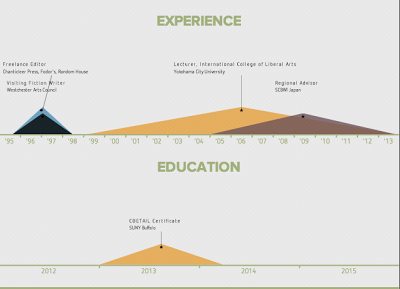

Or if the resume template could accommodate a long and varied career, the information looked crunched and messy, even containing overlapping text.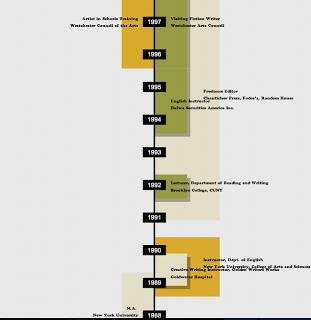
The only option that could display 20+ years of experience in a visually reasonable format used bubbles, but even this theme was not ideal, requiring the viewer to match a letter to information listed below the visual.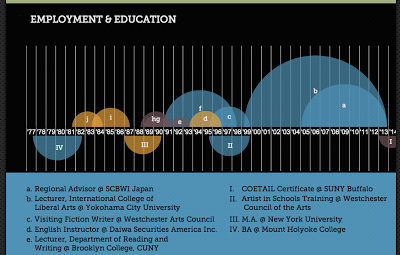
There were various additional fields besides employment and education, such as languages (presented on a world map), skills, interests and stats. But, as one user noted in a comment, it might be more interesting to be able use the rather oversized world map for more than just languages, such as countries in which you've worked or countries in which you've presented.
Completely missing was any way to list key publications on any sort of timeline. Also missing was a field that might parallel experience for including related professional activities or volunteer work.
As I fiddled with these templates, I realized that creating an effective visual resume requires rethinking the resume entirely. Templates like those offered on Visualize.me might best be used as tools for creating a teaser resume, like a book or movie trailer, that serves as a lead in to a traditional resume.
The best visual resumes are mostly likely not created with basic templates but rather are specifically and uniquely custom designed by visual thinkers, either for themselves or for clients. In 4 Rules for Creating a Killer Infographic Resume, on The Daily Muse, we're advised not to even try creating our own visual resume; we should just to go straight to a designer. Funny that the author of the article just happens to be a designer . . .
Us word people come up short once again.
I've been intrigued by the idea of a visual resume. As an educator and writer, a person who teaches about crafting with words, I'm always envious of illustrators and visual artists who can immediately convey to others the essence of their work in just a few images, so I thought I'd try creating a visual resume for my teaching and writing career.
I experimented with visualize.me since, at a glance, I liked the simplicity of some of their online examples. But I discovered that there were some serious limitations to the templates.
I tried several themes/formats. Most could not visually display my career, which happens to span more years than most of the templates allow. Some templates would only show experience and education since 1998.


Or if the resume template could accommodate a long and varied career, the information looked crunched and messy, even containing overlapping text.

The only option that could display 20+ years of experience in a visually reasonable format used bubbles, but even this theme was not ideal, requiring the viewer to match a letter to information listed below the visual.

There were various additional fields besides employment and education, such as languages (presented on a world map), skills, interests and stats. But, as one user noted in a comment, it might be more interesting to be able use the rather oversized world map for more than just languages, such as countries in which you've worked or countries in which you've presented.
Completely missing was any way to list key publications on any sort of timeline. Also missing was a field that might parallel experience for including related professional activities or volunteer work.
As I fiddled with these templates, I realized that creating an effective visual resume requires rethinking the resume entirely. Templates like those offered on Visualize.me might best be used as tools for creating a teaser resume, like a book or movie trailer, that serves as a lead in to a traditional resume.
The best visual resumes are mostly likely not created with basic templates but rather are specifically and uniquely custom designed by visual thinkers, either for themselves or for clients. In 4 Rules for Creating a Killer Infographic Resume, on The Daily Muse, we're advised not to even try creating our own visual resume; we should just to go straight to a designer. Funny that the author of the article just happens to be a designer . . .
Us word people come up short once again.
Published on October 14, 2013 06:49
October 4, 2013
COETAIL: Infographics for Teaching Understanding American Culture
Another post toward obtaining my Certificate in Educational Technology and Information Literacy (COETAIL)
At my Japanese university, I teach two sections of the course Understanding American Culture, in which we explore the U.S. through its history of immigration, beginning with Bering Strait land bridge theory and moving into European immigration, examining slave trade and African Americans, and covering past and current patterns of immigration among major immigrant groups (e.g. Latin Americans, Asian Americans, etc.). Students then research an immigrant subgroup (e.g. Haitian Americans, German Americans, Vietnamese Americans, Cuban Americans, etc.) in teams and give both an informational and a creative, ideally interactive, presentation on that immigrant group. I've developed this course over the last seven years, and each year I tweak and update the course contents, so I'm always seeking out new materials to share with my students.
Given the development of infographics (such as these infographics on Visual.ly)as a means of communicating data, I've been searching for U.S. immigration information presented visually. Due to the U.S. government shutdown, as of this writing, census.gov and other key websites are not available. I should have done this COETAIL homework last week . . .
Some material in infographics, like this from Visual.ly seems overly simplistic:

From Visually.
Some immigration focused infographics strike me as visually cute, but not especially helpful to my class:
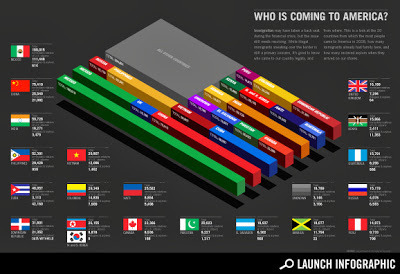 from Good Infographics
from Good Infographics
These Washington Post infographics on the state of immigration in the U.S. may actually be helpful for discussing matters of politics and terminology, since in these visuals Mexican immigrants are not included in the data for North American immigration to the U.S., but rather in the data for Latin American immigrants.
These NPR infographics on Immigrants Working in America, U.S. Workers by Place of Birth and Field of Employment by Place of Birth, will be good to share on the class Wiki, as will these, also from NPR, on 100 Years of Immigrants in America.
The maps below from the Office of Immigration Statistics in the U.S. Department of Homeland Security of Persons Obtaining Legal Residence Status by Country of Last Residence will also be great for my class. At a glance students will quickly be able to discern shifts in immigration trends.
And these below maps showing Persons Obtaining Legal Resident Status by U.S. Census Region or State may also be helpful for my students trying to determining which states on which to focus their research.
I also look forward to sharing these 14 Key Infographics About America's Immigrant Population. I plan to use them in class and develop a related set of questions for students to consider and discuss in groups before showing the infographics.
Sharing these infographics with the students will hopefully inspire them to be even more creative with their own presentations of data about their immigrant group. Now to update the class Wiki with these links.
At my Japanese university, I teach two sections of the course Understanding American Culture, in which we explore the U.S. through its history of immigration, beginning with Bering Strait land bridge theory and moving into European immigration, examining slave trade and African Americans, and covering past and current patterns of immigration among major immigrant groups (e.g. Latin Americans, Asian Americans, etc.). Students then research an immigrant subgroup (e.g. Haitian Americans, German Americans, Vietnamese Americans, Cuban Americans, etc.) in teams and give both an informational and a creative, ideally interactive, presentation on that immigrant group. I've developed this course over the last seven years, and each year I tweak and update the course contents, so I'm always seeking out new materials to share with my students.
Given the development of infographics (such as these infographics on Visual.ly)as a means of communicating data, I've been searching for U.S. immigration information presented visually. Due to the U.S. government shutdown, as of this writing, census.gov and other key websites are not available. I should have done this COETAIL homework last week . . .
Some material in infographics, like this from Visual.ly seems overly simplistic:

From Visually.
Some immigration focused infographics strike me as visually cute, but not especially helpful to my class:
 from Good Infographics
from Good InfographicsThese Washington Post infographics on the state of immigration in the U.S. may actually be helpful for discussing matters of politics and terminology, since in these visuals Mexican immigrants are not included in the data for North American immigration to the U.S., but rather in the data for Latin American immigrants.
These NPR infographics on Immigrants Working in America, U.S. Workers by Place of Birth and Field of Employment by Place of Birth, will be good to share on the class Wiki, as will these, also from NPR, on 100 Years of Immigrants in America.
The maps below from the Office of Immigration Statistics in the U.S. Department of Homeland Security of Persons Obtaining Legal Residence Status by Country of Last Residence will also be great for my class. At a glance students will quickly be able to discern shifts in immigration trends.
And these below maps showing Persons Obtaining Legal Resident Status by U.S. Census Region or State may also be helpful for my students trying to determining which states on which to focus their research.
I also look forward to sharing these 14 Key Infographics About America's Immigrant Population. I plan to use them in class and develop a related set of questions for students to consider and discuss in groups before showing the infographics.
Sharing these infographics with the students will hopefully inspire them to be even more creative with their own presentations of data about their immigrant group. Now to update the class Wiki with these links.
Published on October 04, 2013 21:20
September 23, 2013
COETAIL--Refining a Wakame Presentation
Another post toward obtaining my Certificate in Educational Technology and Information Literacy (COETAIL)
This week I'll be visiting an international school in Tokyo to talk about poetry to grade 3 students and wakame seaweed and The Wakame Gatherers to grade 4 students as part of their healthy eating unit. With poetry I usually let the words talk, let the words take center stage, so I rarely include images in poetry presentations.
For my wakame presentations, however, I use lots of photos from my years of observing wakame cultivation and wakame gathering on the beaches in Kamakura. I take the audience on a virtual journey to Kamakura and show them the steps of the wakame cultivation process and independent wakame gathering.
I have all the images. I've presented on wakame many times. But my PowerPoint needed some sprucing up.

Previously the wakame presentation was full of slides consisting of photos accompanied by some text. In my presentation revision, I cut the words from all except three of the forty slides. The text was completely superfluous.
I also enlarged all of the photos to go beyond the edges of the slides wherever possible. Unfortunately, some of my photos are vertically oriented, so some slides, alas, have white space showing. I'll have to pay attention to camera orientation when taking photos for future presentations.
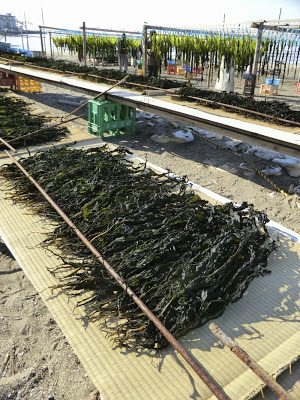
After removing words and enlarging images, I then looked at the overall flow of the presentation and found several slides that interrupted my narration. I reorganized sections so that the presentation now flows much better.
Some people might say 40 images are too many, and admittedly when presenting I tend to skip over about 4-5 slides. But the many images help the children see the setting and the process in detail, so for now, I'll stick to my 40 slides.
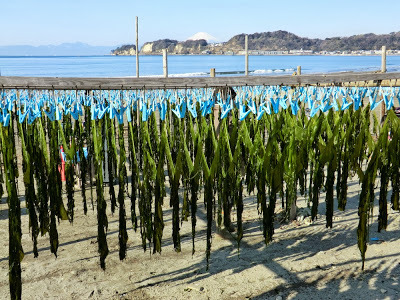
So, in my author visit bag I have my dried wakame. I have my props. I have my spruced up PowerPoint. The one thing I'm missing is a wireless clicker.
And now, in thanks for reading this far, I'll share with you some wakame recipes from Koshigoe, a fishing port neighborhood of Kamakura. These recipes were shared by members of the Koshigoe community.
So aren't you just wishing it were February, with fresh wakame in season?
This week I'll be visiting an international school in Tokyo to talk about poetry to grade 3 students and wakame seaweed and The Wakame Gatherers to grade 4 students as part of their healthy eating unit. With poetry I usually let the words talk, let the words take center stage, so I rarely include images in poetry presentations.
For my wakame presentations, however, I use lots of photos from my years of observing wakame cultivation and wakame gathering on the beaches in Kamakura. I take the audience on a virtual journey to Kamakura and show them the steps of the wakame cultivation process and independent wakame gathering.
I have all the images. I've presented on wakame many times. But my PowerPoint needed some sprucing up.

Previously the wakame presentation was full of slides consisting of photos accompanied by some text. In my presentation revision, I cut the words from all except three of the forty slides. The text was completely superfluous.
I also enlarged all of the photos to go beyond the edges of the slides wherever possible. Unfortunately, some of my photos are vertically oriented, so some slides, alas, have white space showing. I'll have to pay attention to camera orientation when taking photos for future presentations.

After removing words and enlarging images, I then looked at the overall flow of the presentation and found several slides that interrupted my narration. I reorganized sections so that the presentation now flows much better.
Some people might say 40 images are too many, and admittedly when presenting I tend to skip over about 4-5 slides. But the many images help the children see the setting and the process in detail, so for now, I'll stick to my 40 slides.

So, in my author visit bag I have my dried wakame. I have my props. I have my spruced up PowerPoint. The one thing I'm missing is a wireless clicker.
And now, in thanks for reading this far, I'll share with you some wakame recipes from Koshigoe, a fishing port neighborhood of Kamakura. These recipes were shared by members of the Koshigoe community.
So aren't you just wishing it were February, with fresh wakame in season?
Published on September 23, 2013 07:41
September 18, 2013
COETAIL: Teaching the Holocaust and Uncovering Personal Histories in Japan
Another post toward obtaining my Certificate in Educational Technology and Information Literacy (COETAIL)
For a number of years now, I've taught a unit on the Holocaust to my university students in Japan using the simple and beautiful book Hana's Suitcase. Originally I taught this as a study unit integrated into a literature class (as a nonfiction approach to story) but recently, I've taught the topic in a one-week intensive course--i.e. fifteen 90-minute class periods crammed into one week. And, lucky me, I have been able to teach the entire course in the language lab--meaning full access to computers and internet for students and me during each class.

Hana's Suitcase tells the true story of Hana Brady, a Jewish girl growing up in Czechoslovakia during the German occupation. Her story alternates with the story of Fumiko Ishioka, the curator of the Tokyo Holocaust Education Resource Center and her determination to learn more about the girl behind the name painted on a suitcase received for display from the Auschwitz Museum.
In general, students in Japan know little about the Holocaust. They've learned almost nothing about it in school and come into the course with only vague notions of what it was all about. Because the prose in Hana's Suitcase is straightforward, my university EFL students can read it at a fast pace. There are photos. There are documents. They quickly get swept up in the story, and come away inspired by Hana, her brother George, and the indefatigable Fumiko Ishioka.
As one student put it after he finished reading: "Before reading, I thought this is just a miserable story. But it is one side of this book. This story gives us special bravery. More Japanese people should learn this amazing story."
Another student said, "To read the entire book, I learned the importance of paying more attention about not only Japan but also the world and what the past included."
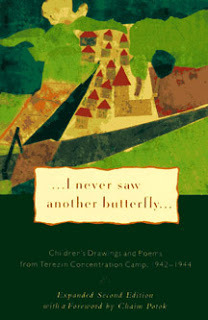 To complement the text, I've created a wiki with links to websites, maps, photos and film clips, audio interviews, and lists of related books and films. In class we view resources, read, discuss and students post comments on the wiki discussion board each day. We read lists of the growing restrictions placed on Jews in Czechoslovakia from 1939-1941. We study maps of the Theresienstadt ghetto, where Hana and her brother were taken. We pore over drawings and paintings created by children in Theresienstadt collected in the book I Never Saw Another Butterfly. These images are incredibly powerful. The pictures, many created under the artistic direction of deported Austrian artist Friedl Dicker-Brandeis using cobbled together art supplies, have enormous emotional impact. Later, one student commented:
To complement the text, I've created a wiki with links to websites, maps, photos and film clips, audio interviews, and lists of related books and films. In class we view resources, read, discuss and students post comments on the wiki discussion board each day. We read lists of the growing restrictions placed on Jews in Czechoslovakia from 1939-1941. We study maps of the Theresienstadt ghetto, where Hana and her brother were taken. We pore over drawings and paintings created by children in Theresienstadt collected in the book I Never Saw Another Butterfly. These images are incredibly powerful. The pictures, many created under the artistic direction of deported Austrian artist Friedl Dicker-Brandeis using cobbled together art supplies, have enormous emotional impact. Later, one student commented:
"Many children drew happy pictures, but some children drew pictures of serious subjects: the ghetto walls, people waiting in line for food, inmates being beaten by Nazi soldiers. How did they feel while drawing these pictures? When I saw these pictures, their sad feelings came down on me."
We also closely examine Hana's drawings and paintings online.
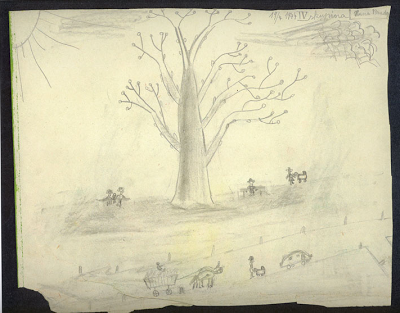 One of Hana's drawings from the Hana's Suitcase website via the Jewish Museum in PragueI also share with students the identification cards I've collected from my visits to the U.S. Holocaust Memorial Museum in Washington, DC.
One of Hana's drawings from the Hana's Suitcase website via the Jewish Museum in PragueI also share with students the identification cards I've collected from my visits to the U.S. Holocaust Memorial Museum in Washington, DC.
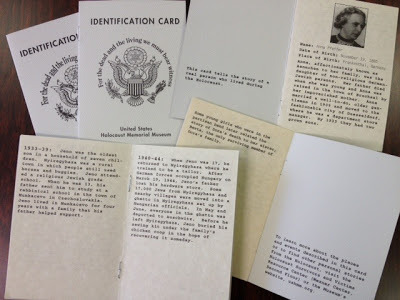
Then we look through the museum's online collection of identitification cards--of individuals who survived and individuals who perished in the Holocaust.
We consider other genocides in history, and current conflicts around the world that might be considered genocide.
I then send my students in a different direction, looking at war experiences of someone they know. I assign a personal history project to create an identification card of a person they can interview who lived through the WWII/Pacific War years--a relative, a family friend, a neighbor or community member. The ID card is to follow the same basic organizational structure as the U.S. Holocaust Memorial Museum ID cards. On the final day, students present to the class the profile of the individual they interviewed.
Doing all this in a one-week course is, well, intensive. My students impress me though, and they are always enthusiastic about the course and the final project. One student said after the recent intensive, "I learned I should know my family's story and I should hand it down to my children. Even though Japan is a very small island country, there are tons of stories about the war time."
Here, with student and family permission, are three personal histories gathered by my university students. (These particular personal histories happen to be all of men, but in my full collection of these histories collected over the years I've been teaching this unit, there are many women as well.)
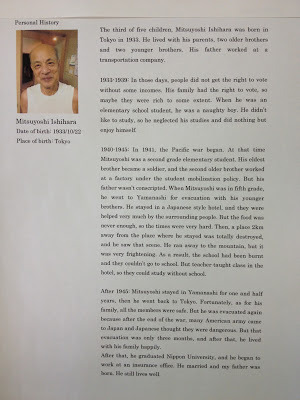

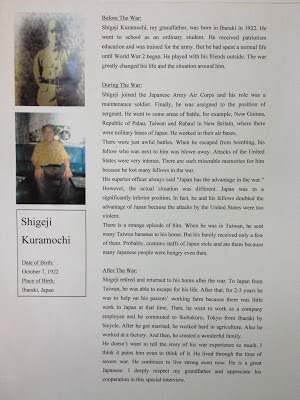
In COETAIL course 3, our current focus is visual literacy, and I am acutely aware of how this study-unit-turned-intensive-course has evolved with technology over the years since I first taught it in 2005, and how my own visual literacy has developed since then. So many primary documents are now viewable online for the Holocaust education portion of the course. Interactive maps are a link away. Photos are easy to click through. Film clips are easy to find and view. And no more stacks of copying for me. My university students are also fairly visually literate. And for the interview part of the course, more elderly Japanese are now online or someone nearby is, able to share current and early photos of themselves and to email them to the interviewer student.
So, wouldn't it be amazing now to have university classrooms all over Japan, even Asia, doing this project? (And wouldn't it be brilliant if I could teach all my classes in rooms with computer and internet access for all students?)
For a number of years now, I've taught a unit on the Holocaust to my university students in Japan using the simple and beautiful book Hana's Suitcase. Originally I taught this as a study unit integrated into a literature class (as a nonfiction approach to story) but recently, I've taught the topic in a one-week intensive course--i.e. fifteen 90-minute class periods crammed into one week. And, lucky me, I have been able to teach the entire course in the language lab--meaning full access to computers and internet for students and me during each class.

Hana's Suitcase tells the true story of Hana Brady, a Jewish girl growing up in Czechoslovakia during the German occupation. Her story alternates with the story of Fumiko Ishioka, the curator of the Tokyo Holocaust Education Resource Center and her determination to learn more about the girl behind the name painted on a suitcase received for display from the Auschwitz Museum.
In general, students in Japan know little about the Holocaust. They've learned almost nothing about it in school and come into the course with only vague notions of what it was all about. Because the prose in Hana's Suitcase is straightforward, my university EFL students can read it at a fast pace. There are photos. There are documents. They quickly get swept up in the story, and come away inspired by Hana, her brother George, and the indefatigable Fumiko Ishioka.
As one student put it after he finished reading: "Before reading, I thought this is just a miserable story. But it is one side of this book. This story gives us special bravery. More Japanese people should learn this amazing story."
Another student said, "To read the entire book, I learned the importance of paying more attention about not only Japan but also the world and what the past included."
 To complement the text, I've created a wiki with links to websites, maps, photos and film clips, audio interviews, and lists of related books and films. In class we view resources, read, discuss and students post comments on the wiki discussion board each day. We read lists of the growing restrictions placed on Jews in Czechoslovakia from 1939-1941. We study maps of the Theresienstadt ghetto, where Hana and her brother were taken. We pore over drawings and paintings created by children in Theresienstadt collected in the book I Never Saw Another Butterfly. These images are incredibly powerful. The pictures, many created under the artistic direction of deported Austrian artist Friedl Dicker-Brandeis using cobbled together art supplies, have enormous emotional impact. Later, one student commented:
To complement the text, I've created a wiki with links to websites, maps, photos and film clips, audio interviews, and lists of related books and films. In class we view resources, read, discuss and students post comments on the wiki discussion board each day. We read lists of the growing restrictions placed on Jews in Czechoslovakia from 1939-1941. We study maps of the Theresienstadt ghetto, where Hana and her brother were taken. We pore over drawings and paintings created by children in Theresienstadt collected in the book I Never Saw Another Butterfly. These images are incredibly powerful. The pictures, many created under the artistic direction of deported Austrian artist Friedl Dicker-Brandeis using cobbled together art supplies, have enormous emotional impact. Later, one student commented: "Many children drew happy pictures, but some children drew pictures of serious subjects: the ghetto walls, people waiting in line for food, inmates being beaten by Nazi soldiers. How did they feel while drawing these pictures? When I saw these pictures, their sad feelings came down on me."
We also closely examine Hana's drawings and paintings online.
 One of Hana's drawings from the Hana's Suitcase website via the Jewish Museum in PragueI also share with students the identification cards I've collected from my visits to the U.S. Holocaust Memorial Museum in Washington, DC.
One of Hana's drawings from the Hana's Suitcase website via the Jewish Museum in PragueI also share with students the identification cards I've collected from my visits to the U.S. Holocaust Memorial Museum in Washington, DC.
Then we look through the museum's online collection of identitification cards--of individuals who survived and individuals who perished in the Holocaust.
We consider other genocides in history, and current conflicts around the world that might be considered genocide.
I then send my students in a different direction, looking at war experiences of someone they know. I assign a personal history project to create an identification card of a person they can interview who lived through the WWII/Pacific War years--a relative, a family friend, a neighbor or community member. The ID card is to follow the same basic organizational structure as the U.S. Holocaust Memorial Museum ID cards. On the final day, students present to the class the profile of the individual they interviewed.
Doing all this in a one-week course is, well, intensive. My students impress me though, and they are always enthusiastic about the course and the final project. One student said after the recent intensive, "I learned I should know my family's story and I should hand it down to my children. Even though Japan is a very small island country, there are tons of stories about the war time."
Here, with student and family permission, are three personal histories gathered by my university students. (These particular personal histories happen to be all of men, but in my full collection of these histories collected over the years I've been teaching this unit, there are many women as well.)



In COETAIL course 3, our current focus is visual literacy, and I am acutely aware of how this study-unit-turned-intensive-course has evolved with technology over the years since I first taught it in 2005, and how my own visual literacy has developed since then. So many primary documents are now viewable online for the Holocaust education portion of the course. Interactive maps are a link away. Photos are easy to click through. Film clips are easy to find and view. And no more stacks of copying for me. My university students are also fairly visually literate. And for the interview part of the course, more elderly Japanese are now online or someone nearby is, able to share current and early photos of themselves and to email them to the interviewer student.
So, wouldn't it be amazing now to have university classrooms all over Japan, even Asia, doing this project? (And wouldn't it be brilliant if I could teach all my classes in rooms with computer and internet access for all students?)
Published on September 18, 2013 00:07
September 8, 2013
Teacher's and Reader's Guide for The Language Inside
Over the summer I collaborated with Anna J. Boll to create . . . drumroll please . . .
The Language Inside: A Discussion, Writing, Activity and Service Guide for Teachers and Readers
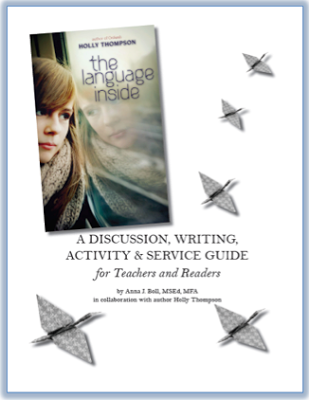 The Language Inside GUIDEI'm so pleased to be able to announce this extensive guide to my young adult verse novel The Language Inside for classrooms, book groups, readers and writers. Included are wide-ranging discussion questions, essay topics, loads of poetry prompts, extension activities, service project ideas and recommended resources. Thirteen pages worth!
The Language Inside GUIDEI'm so pleased to be able to announce this extensive guide to my young adult verse novel The Language Inside for classrooms, book groups, readers and writers. Included are wide-ranging discussion questions, essay topics, loads of poetry prompts, extension activities, service project ideas and recommended resources. Thirteen pages worth!
To download your copy, visit this page of my website.
Enjoy and do send feedback! And I so look forward to reading student's poems created from the prompts in this guide.
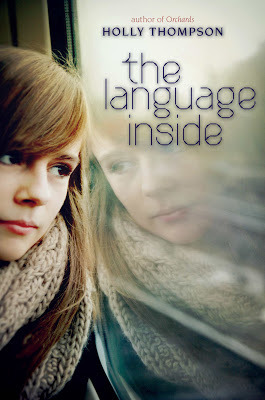 The Language Inside
Anna J. Boll was wonderful to collaborate with in creating this guide. You can check out her services here.
The Language Inside
Anna J. Boll was wonderful to collaborate with in creating this guide. You can check out her services here.
The Language Inside: A Discussion, Writing, Activity and Service Guide for Teachers and Readers
 The Language Inside GUIDEI'm so pleased to be able to announce this extensive guide to my young adult verse novel The Language Inside for classrooms, book groups, readers and writers. Included are wide-ranging discussion questions, essay topics, loads of poetry prompts, extension activities, service project ideas and recommended resources. Thirteen pages worth!
The Language Inside GUIDEI'm so pleased to be able to announce this extensive guide to my young adult verse novel The Language Inside for classrooms, book groups, readers and writers. Included are wide-ranging discussion questions, essay topics, loads of poetry prompts, extension activities, service project ideas and recommended resources. Thirteen pages worth!To download your copy, visit this page of my website.
Enjoy and do send feedback! And I so look forward to reading student's poems created from the prompts in this guide.
 The Language Inside
Anna J. Boll was wonderful to collaborate with in creating this guide. You can check out her services here.
The Language Inside
Anna J. Boll was wonderful to collaborate with in creating this guide. You can check out her services here.
Published on September 08, 2013 05:09
September 5, 2013
Sakurajima Volcanic Eruptions and ASH
My novel Ash (Stone Bridge Press) is partly set in the Japanese city of Kagoshima which lies opposite the very active volcano Sakurajima.

This August, Sakurajima experienced a huge eruption, the largest in decades. The conditions shown in this BBC video give a sense of what it's like when Sakurajima drops ash on the city.
Here is the opening of an article recently featured in the newspaper Nihon Minami-Shimbun. The article was written by Yokohama City University professor and Kagoshima native Toru Iwasaki and features Ash, Orchards and the anthology Tomo.
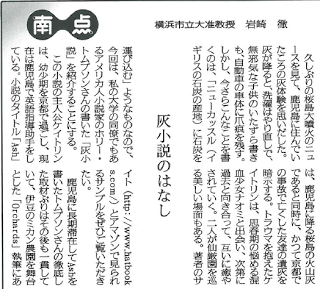
And, as a result of my participation in the Hong Kong International Writers Workshop and the related visit to China in October and November 2012, the prologue and first chapter of Ash were translated into Mandarin Chinese and appeared in the monthly 作家Writer Magazine in the May 2013 issue (pp. 24-28).

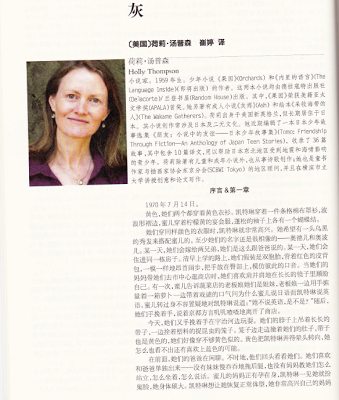 They even included an illustration of Sakurajima spewing ash.
They even included an illustration of Sakurajima spewing ash.
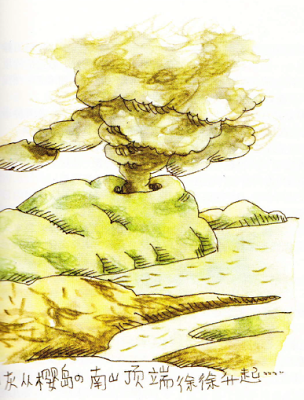
As of this posting, close to 600 Sakurajima eruptions have occurred in 2013 (here is the NHK log of Sakurajima activity). More Sakurajima eruptions are predicted this year, so if you haven't read Ash yet (for New Adults and Adults), now might be a good time!

This August, Sakurajima experienced a huge eruption, the largest in decades. The conditions shown in this BBC video give a sense of what it's like when Sakurajima drops ash on the city.
Here is the opening of an article recently featured in the newspaper Nihon Minami-Shimbun. The article was written by Yokohama City University professor and Kagoshima native Toru Iwasaki and features Ash, Orchards and the anthology Tomo.

And, as a result of my participation in the Hong Kong International Writers Workshop and the related visit to China in October and November 2012, the prologue and first chapter of Ash were translated into Mandarin Chinese and appeared in the monthly 作家Writer Magazine in the May 2013 issue (pp. 24-28).

 They even included an illustration of Sakurajima spewing ash.
They even included an illustration of Sakurajima spewing ash.
As of this posting, close to 600 Sakurajima eruptions have occurred in 2013 (here is the NHK log of Sakurajima activity). More Sakurajima eruptions are predicted this year, so if you haven't read Ash yet (for New Adults and Adults), now might be a good time!
Published on September 05, 2013 16:00
September 4, 2013
Meeting Children's and YA Writers in New Delhi
Books, writing and teaching have taken me on some incredible journeys! Barely a week after returning from the U.S. to Japan, I flew to New Delhi, to present at the Jumpstart Festival and conduct a writing workshop for SCBWI India.
I had the good fortune to be put up at a guest house across the road from the Lodhi Gardens, where each morning I started my day with a sunrise walk around the perimeter.
 Lodhi Gardens
Lodhi Gardens
 Lodhi Gardens
Lodhi Gardens
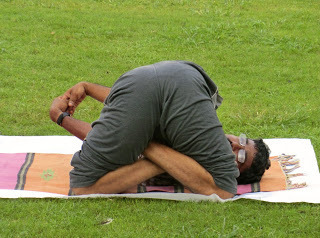 How some other folks start their dayJumpstart, as explained on the festival website, "has grown from two masterclasses for writers and illustrators in 2009 to a keenly anticipated annual gathering for any and everyone in the Indian children's book trade." This year's festival lasted two days, under the theme "Speaking in Tongues." Day 1 included four panel discussions: The Great Language Debate featuring diverging views on language; The Language Playground which centered on nonsense writing; Art as Language, Designer as Author featuring illustrators and designers; and Speaking in Tongues with four translators.
How some other folks start their dayJumpstart, as explained on the festival website, "has grown from two masterclasses for writers and illustrators in 2009 to a keenly anticipated annual gathering for any and everyone in the Indian children's book trade." This year's festival lasted two days, under the theme "Speaking in Tongues." Day 1 included four panel discussions: The Great Language Debate featuring diverging views on language; The Language Playground which centered on nonsense writing; Art as Language, Designer as Author featuring illustrators and designers; and Speaking in Tongues with four translators.
 My co-panelists for The Great Language Debate: Manisha Chaudhry, Subir Shukla and Alok Rai
My co-panelists for The Great Language Debate: Manisha Chaudhry, Subir Shukla and Alok Rai
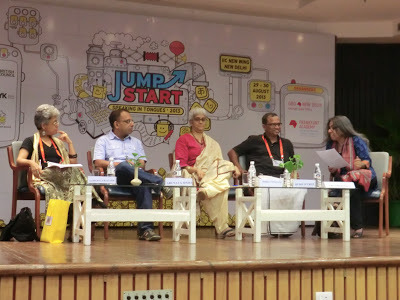 Translation panel Sampurna Chattarji, Arunava Sinha, Shobha Viswanath, Rubin D'Cruz and Urvashi ButaliaThe new guidebook 101 Indian Children's Books We Love! was officially launched during the festival--this guide lists 101 of the best children's books available in India, and many of those books were on display during the festival.
Translation panel Sampurna Chattarji, Arunava Sinha, Shobha Viswanath, Rubin D'Cruz and Urvashi ButaliaThe new guidebook 101 Indian Children's Books We Love! was officially launched during the festival--this guide lists 101 of the best children's books available in India, and many of those books were on display during the festival.
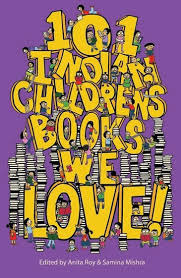
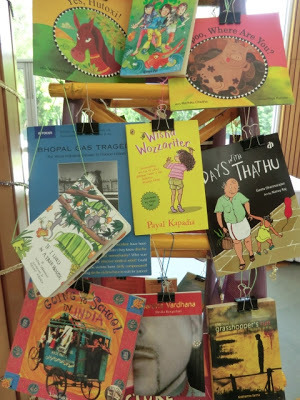 Some of the 101 books listed in the guideThe Day 1 evening event was a cocktail party hosted by the Oxford Bookstore.
Some of the 101 books listed in the guideThe Day 1 evening event was a cocktail party hosted by the Oxford Bookstore.
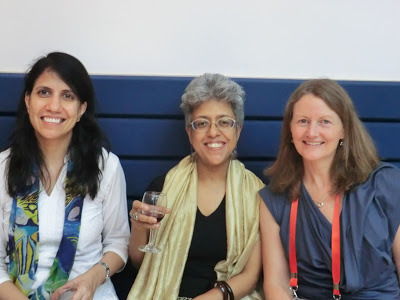 Oxford Bookstore party
Oxford Bookstore party
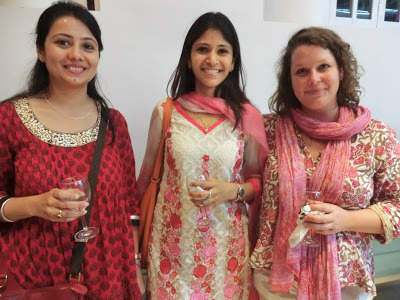 Some of the lovely folks from the German Book Office at the Oxford Bookstore party
Some of the lovely folks from the German Book Office at the Oxford Bookstore party
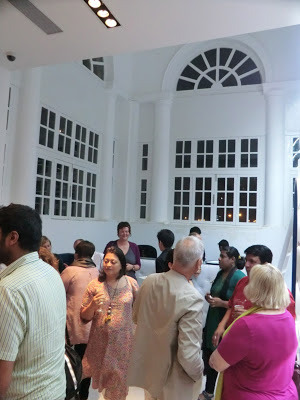 Oxford Bookstore partyDay 2 included all-day masterclasses--an Illustration Masterclass taught by Julia Kaergel of Germany and Emily Gravett from the U.K., and a Writing Masterclass taught by myself with author and Duckbill Books publisher Anushka Ravishankar (read an interview of Anushka on Saffron Tree here). At the end of the day a Book Souk offered the opportunity for participants to pitch manuscripts and ideas to publishers.
Oxford Bookstore partyDay 2 included all-day masterclasses--an Illustration Masterclass taught by Julia Kaergel of Germany and Emily Gravett from the U.K., and a Writing Masterclass taught by myself with author and Duckbill Books publisher Anushka Ravishankar (read an interview of Anushka on Saffron Tree here). At the end of the day a Book Souk offered the opportunity for participants to pitch manuscripts and ideas to publishers.
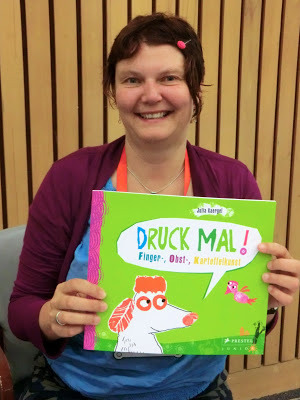 Illustrator Julia Kaergel ready to lead her Illustration Masterclass
Illustrator Julia Kaergel ready to lead her Illustration Masterclass
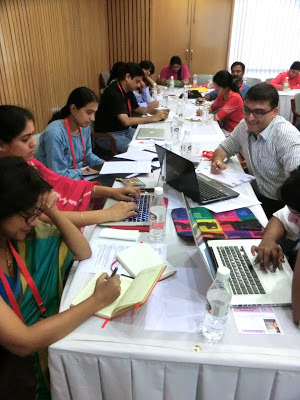 Writers drafting a scene in the Writing Masterclass
Writers drafting a scene in the Writing Masterclass
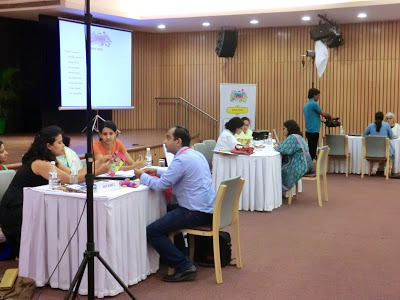 Pitching manuscripts to editors and publishers at the Book SoukThe next day I presented a workshop for SCBWI India: Writing Across Boundaries of Languages, Cultures and Class, held at the home of Duckbill Books.
Pitching manuscripts to editors and publishers at the Book SoukThe next day I presented a workshop for SCBWI India: Writing Across Boundaries of Languages, Cultures and Class, held at the home of Duckbill Books.
 SCBWI India workshop--writers responding to a prompt
SCBWI India workshop--writers responding to a prompt
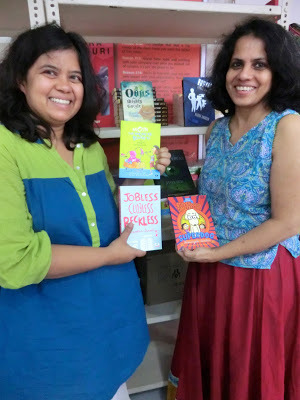 Sayoni Basu and Anushka Ravishankar of Duckbill BooksThat afternoon I joined Anushka to read from our Japan-focused picture books--Anushka read her retelling of a Japanese folk tale The Boy Who Drew Cats, and I read The Wakame Gatherers. I gave away my copy of The Wakame Gatherers to two young sisters whose father shared that they have a Japanese mother.
Sayoni Basu and Anushka Ravishankar of Duckbill BooksThat afternoon I joined Anushka to read from our Japan-focused picture books--Anushka read her retelling of a Japanese folk tale The Boy Who Drew Cats, and I read The Wakame Gatherers. I gave away my copy of The Wakame Gatherers to two young sisters whose father shared that they have a Japanese mother.
 Anushka Ravishankar reading The Boy Who Drew Cats
Anushka Ravishankar reading The Boy Who Drew Cats
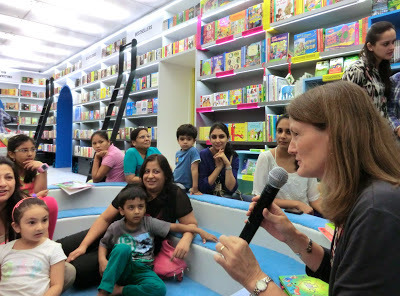 Me introducing The Wakame Gatherers and the idea of seaweed as foodI enjoyed a final day of sightseeing with illustrator Julia Kaergel in the morning, and with some Japan friends in the afternoon.
Me introducing The Wakame Gatherers and the idea of seaweed as foodI enjoyed a final day of sightseeing with illustrator Julia Kaergel in the morning, and with some Japan friends in the afternoon.
 Humayun's Tomb
Humayun's Tomb
 Taking a break in the shade
Taking a break in the shade
 Entering the massive Red FortHuge thanks to the German Book Office, to everyone involved in the Jumpstart Festival, and to SCBWI India. I almost didn't get my visa in time, and it was a whirlwind trip, but it couldn't have been better!
Entering the massive Red FortHuge thanks to the German Book Office, to everyone involved in the Jumpstart Festival, and to SCBWI India. I almost didn't get my visa in time, and it was a whirlwind trip, but it couldn't have been better!
 Jumpstart Programme Officers Anita Roy and Sirish Rao, myself and illustrator Julia KaergelI look forward to reading more and more children's and young adult books from India.
Jumpstart Programme Officers Anita Roy and Sirish Rao, myself and illustrator Julia KaergelI look forward to reading more and more children's and young adult books from India.
I had the good fortune to be put up at a guest house across the road from the Lodhi Gardens, where each morning I started my day with a sunrise walk around the perimeter.
 Lodhi Gardens
Lodhi Gardens
 Lodhi Gardens
Lodhi Gardens
 How some other folks start their dayJumpstart, as explained on the festival website, "has grown from two masterclasses for writers and illustrators in 2009 to a keenly anticipated annual gathering for any and everyone in the Indian children's book trade." This year's festival lasted two days, under the theme "Speaking in Tongues." Day 1 included four panel discussions: The Great Language Debate featuring diverging views on language; The Language Playground which centered on nonsense writing; Art as Language, Designer as Author featuring illustrators and designers; and Speaking in Tongues with four translators.
How some other folks start their dayJumpstart, as explained on the festival website, "has grown from two masterclasses for writers and illustrators in 2009 to a keenly anticipated annual gathering for any and everyone in the Indian children's book trade." This year's festival lasted two days, under the theme "Speaking in Tongues." Day 1 included four panel discussions: The Great Language Debate featuring diverging views on language; The Language Playground which centered on nonsense writing; Art as Language, Designer as Author featuring illustrators and designers; and Speaking in Tongues with four translators. My co-panelists for The Great Language Debate: Manisha Chaudhry, Subir Shukla and Alok Rai
My co-panelists for The Great Language Debate: Manisha Chaudhry, Subir Shukla and Alok Rai
 Translation panel Sampurna Chattarji, Arunava Sinha, Shobha Viswanath, Rubin D'Cruz and Urvashi ButaliaThe new guidebook 101 Indian Children's Books We Love! was officially launched during the festival--this guide lists 101 of the best children's books available in India, and many of those books were on display during the festival.
Translation panel Sampurna Chattarji, Arunava Sinha, Shobha Viswanath, Rubin D'Cruz and Urvashi ButaliaThe new guidebook 101 Indian Children's Books We Love! was officially launched during the festival--this guide lists 101 of the best children's books available in India, and many of those books were on display during the festival.
 Some of the 101 books listed in the guideThe Day 1 evening event was a cocktail party hosted by the Oxford Bookstore.
Some of the 101 books listed in the guideThe Day 1 evening event was a cocktail party hosted by the Oxford Bookstore. Oxford Bookstore party
Oxford Bookstore party
 Some of the lovely folks from the German Book Office at the Oxford Bookstore party
Some of the lovely folks from the German Book Office at the Oxford Bookstore party
 Oxford Bookstore partyDay 2 included all-day masterclasses--an Illustration Masterclass taught by Julia Kaergel of Germany and Emily Gravett from the U.K., and a Writing Masterclass taught by myself with author and Duckbill Books publisher Anushka Ravishankar (read an interview of Anushka on Saffron Tree here). At the end of the day a Book Souk offered the opportunity for participants to pitch manuscripts and ideas to publishers.
Oxford Bookstore partyDay 2 included all-day masterclasses--an Illustration Masterclass taught by Julia Kaergel of Germany and Emily Gravett from the U.K., and a Writing Masterclass taught by myself with author and Duckbill Books publisher Anushka Ravishankar (read an interview of Anushka on Saffron Tree here). At the end of the day a Book Souk offered the opportunity for participants to pitch manuscripts and ideas to publishers. Illustrator Julia Kaergel ready to lead her Illustration Masterclass
Illustrator Julia Kaergel ready to lead her Illustration Masterclass
 Writers drafting a scene in the Writing Masterclass
Writers drafting a scene in the Writing Masterclass
 Pitching manuscripts to editors and publishers at the Book SoukThe next day I presented a workshop for SCBWI India: Writing Across Boundaries of Languages, Cultures and Class, held at the home of Duckbill Books.
Pitching manuscripts to editors and publishers at the Book SoukThe next day I presented a workshop for SCBWI India: Writing Across Boundaries of Languages, Cultures and Class, held at the home of Duckbill Books. SCBWI India workshop--writers responding to a prompt
SCBWI India workshop--writers responding to a prompt
 Sayoni Basu and Anushka Ravishankar of Duckbill BooksThat afternoon I joined Anushka to read from our Japan-focused picture books--Anushka read her retelling of a Japanese folk tale The Boy Who Drew Cats, and I read The Wakame Gatherers. I gave away my copy of The Wakame Gatherers to two young sisters whose father shared that they have a Japanese mother.
Sayoni Basu and Anushka Ravishankar of Duckbill BooksThat afternoon I joined Anushka to read from our Japan-focused picture books--Anushka read her retelling of a Japanese folk tale The Boy Who Drew Cats, and I read The Wakame Gatherers. I gave away my copy of The Wakame Gatherers to two young sisters whose father shared that they have a Japanese mother. Anushka Ravishankar reading The Boy Who Drew Cats
Anushka Ravishankar reading The Boy Who Drew Cats
 Me introducing The Wakame Gatherers and the idea of seaweed as foodI enjoyed a final day of sightseeing with illustrator Julia Kaergel in the morning, and with some Japan friends in the afternoon.
Me introducing The Wakame Gatherers and the idea of seaweed as foodI enjoyed a final day of sightseeing with illustrator Julia Kaergel in the morning, and with some Japan friends in the afternoon. Humayun's Tomb
Humayun's Tomb
 Taking a break in the shade
Taking a break in the shade
 Entering the massive Red FortHuge thanks to the German Book Office, to everyone involved in the Jumpstart Festival, and to SCBWI India. I almost didn't get my visa in time, and it was a whirlwind trip, but it couldn't have been better!
Entering the massive Red FortHuge thanks to the German Book Office, to everyone involved in the Jumpstart Festival, and to SCBWI India. I almost didn't get my visa in time, and it was a whirlwind trip, but it couldn't have been better! Jumpstart Programme Officers Anita Roy and Sirish Rao, myself and illustrator Julia KaergelI look forward to reading more and more children's and young adult books from India.
Jumpstart Programme Officers Anita Roy and Sirish Rao, myself and illustrator Julia KaergelI look forward to reading more and more children's and young adult books from India.
Published on September 04, 2013 07:36



